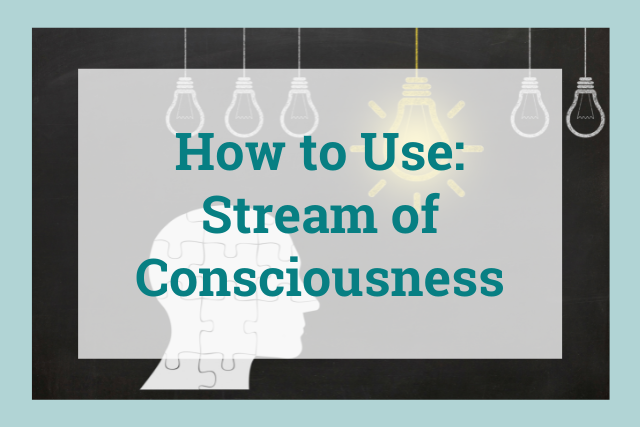
Have you ever read a story that felt like you were deep in the brain of the protagonist? Instead of being told the story in order, you feel like you are hearing another person’s thoughts. This is a literary technique called "stream of consciousness."
What Is Stream of Consciousness Writing?
It’s difficult to give one singular stream of consciousness definition.
Writers use stream of consciousness writing to mimic the way people’s thoughts flow. We very rarely think in a perfect, linear order. The stream of consciousness technique uses unusual, often grammatically incorrect, sentence structure full of incomplete thoughts and tangents to illustrate how a character thinks.
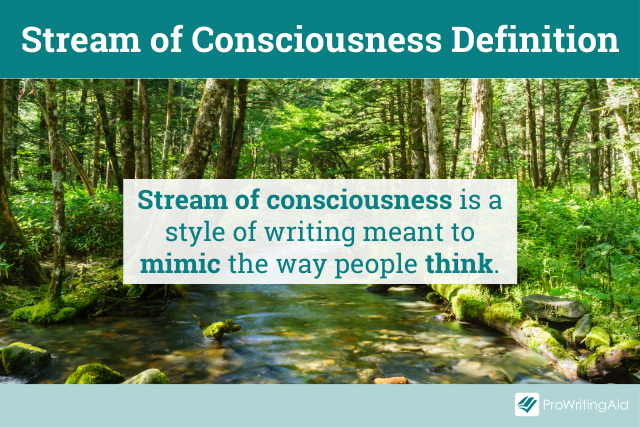
Stream of consciousness writing can be frustrating for many readers because the storytelling doesn’t flow in a logical manner.
However, stream of consciousness is a powerful tool when the theme of the story lies not in the events of the story, but a character’s perspective of the events.
A stream of consciousness narrative is one of the best ways to really capture human emotion in writing.
But where did this technique come from?
What Is Stream of Consciousness in Psychology?
Stream of consciousness is actually a term taken from the field of psychology, but its roots go even further back.
Many early Buddhist writings refer to the "mind stream" and the "consciousness stream." These teachings reference the way thoughts flow through a mind like moving water.
Even without the spiritual aspect, this metaphor was useful for early psychologists.
William James, a psychologist in the second half of the nineteenth century, used his philosophy background to coin the phrase "stream of consciousness."
James, often called the Father of American Psychology, said this quickly moving stream of observations and emotions represents the full range of conscious thought.
In the late 1800s and early 1900s, writers began to take this idea and apply it to their work to provide a realistic type of characterization for their works.
We’ll cover the history of this literary device further down.
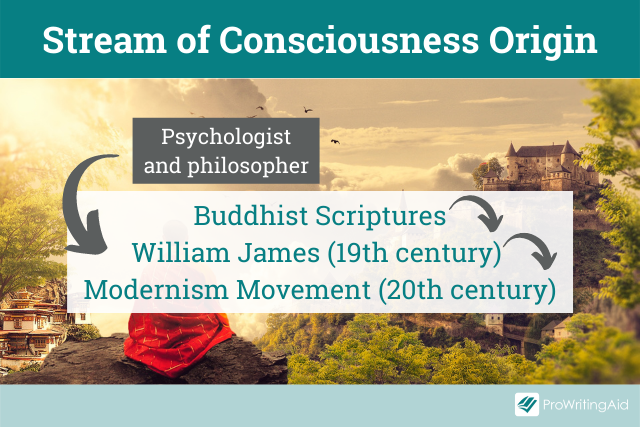
Why Do Writers Use Stream of Consciousness in Literature?
So why do writers use stream of consciousness?
For centuries, the art of storytelling focused on the events of a story. Stories were expected to be linear. The characters’ thoughts and emotions were often not the driving force of a story. When they were, these thoughts and emotions were written like the rest of the narrative: linearly, with proper grammar conventions.
Stream of consciousness writing, on the other hand, takes you on a journey through a character’s mind. It allows for a grittiness that you can’t achieve with an ordered internal monologue. While stream of consciousness might read somewhat more surrealist than traditional storytelling, it’s the most realistic representation of human thought.
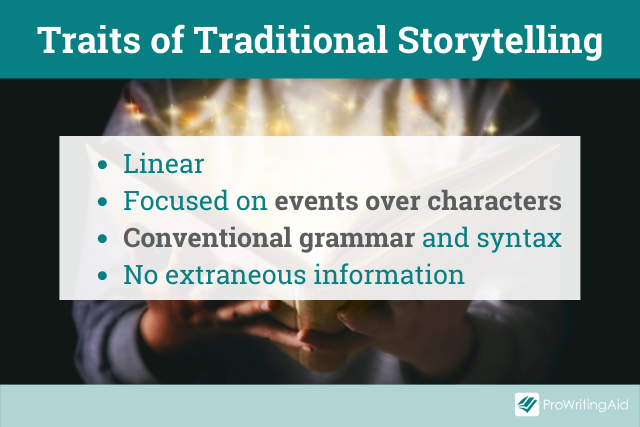
What’s the History of Stream of Consciousness Writing?
The late 1800s and early 1900s were a period of major transition throughout much of the world.
With economic and social reforms and revolutions occurring from the Americas to Russia, as well as leaps in the sciences, the arts began to transition as well.
There was a desire to put an element of humanity into the arts that had been previously overlooked.
In the late 1800s, writers such as Edgar Allen Poe, Leo Tolstoy, and Anton Chekhov began to play with different styles of narration. These authors were predecessors of the Modernist movement.
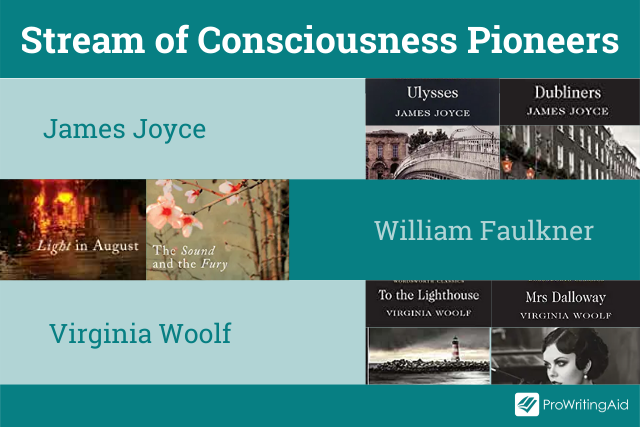
The Modernism movement was about intentionally breaking writing rules and expectations.
Many Modernists, like James Joyce and Virginia Woolf, adopted the idea of stream of consciousness from psychology and applied it to their poetry and literature. The term was first used in 1918 to describe Dorothy Richardson’s novel series Pilgrimage.
Stream of consciousness writing became even more popular in the mid-twentieth century with writers like Jack Kerouac and Sylvia Plath. Authors like Margaret Atwood and Brendan Connell still use this technique today.
Want to learn more about how your favorite authors write?
Compare your writing to dozens of popular authors in the ProWritingAid Summary Report. You’ll see how they use dialogue tags, sentence length variety, emotional tells, and more.
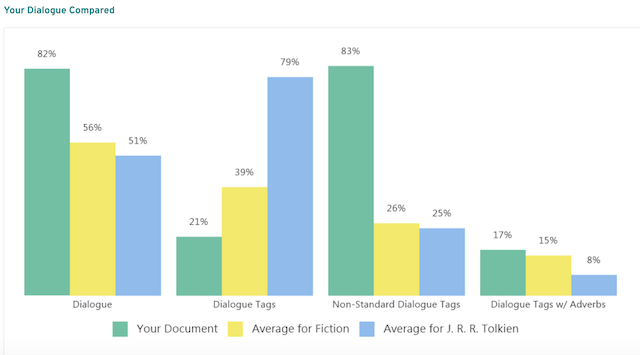
Try it for free with a free ProWritingAid account.
How to Write a Stream of Consciousness Story
If you’re writing a heavily character-driven story, stream of consciousness can be a powerful technique. It allows your readers to become intimate with your protagonist, to truly know them, so they can experience the story along with them.
Stream of consciousness is most effective when there is only one point of view (POV) for a story. If you’re writing an omniscient perspective or you have alternating points of view, it’s better to choose another narration style.
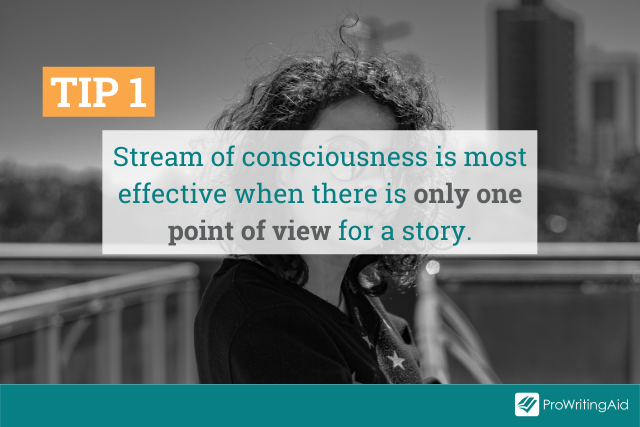
If you do choose to have multiple points of view, spend time ensuring that the voice of each character is strong enough for readers to differentiate. Readers should be able to easily identify which character’s consciousness they are experiencing.
To master stream of consciousness writing, you need to be very aware of how a person thinks, not just what they think. Practice becoming aware of your own consciousness stream. Pay attention to how your thoughts jump around.
One effective way to do this is by journaling. Julia Cameron, in her book The Artist’s Way, presented the idea of "morning pages." She recommends handwriting three pages in the early morning, filling them with your stream of consciousness. If it comes to your mind, it gets written down. You don’t stop writing until the three pages are finished.
Once you have a better grasp of how streams of consciousness flow, you can apply it to your characters.
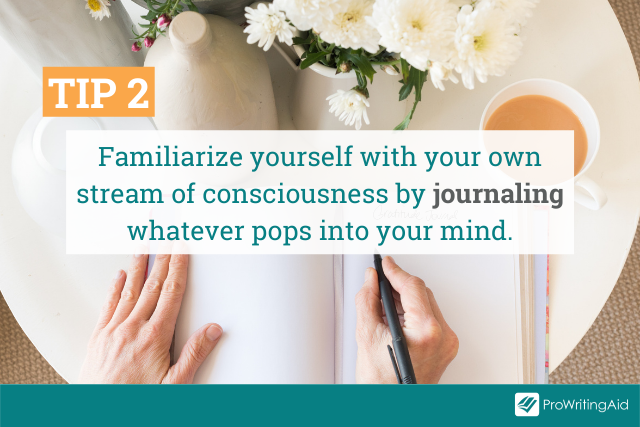
Does Stream of Consciousness Have to Be Written in First-Person POV?
Because stream of consciousness lets you into the depths of a character’s mind, your story’s POV should be limited to just that character.
First-person POV is the obvious choice. However, you can effectively write stream of consciousness in the third-person limited POV.
You can also include some instances of second-person (i.e. "you") within your narration. It makes the narration feel like a conversation between the character and the reader.
Is Writing Stream of Consciousness Hard?
You might think that stream of consciousness writing has no rules because it reads rather chaotic. However, it’s hard work to write that chaos in a way that still tells a story.
First, ensure that your story is the right story for this technique. A historical or fantasy epic, where the events are more important than a character’s reaction to them, is probably not the best choice. Stream of consciousness tends to appear in literary fiction as opposed to genre fiction.
I’m not saying it can’t be done! But the message and themes in your stream of consciousness story should come from the character’s deepest thoughts, not from external events.
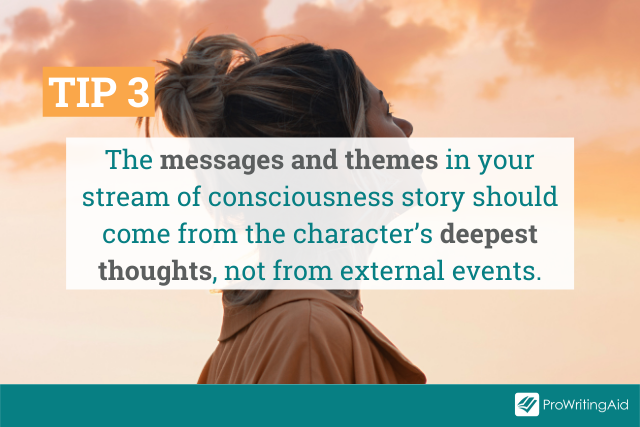
What Features Does Stream of Consciousness Writing Require?
There are a few elements that give stream of consciousness writing its signature flow.
One of these is grammar and syntax. Run-on sentences paired with sentence fragments mimic how people speak and think. We also use interjections.
Use punctuation to help you master this syntax.
Play with dashes, ellipses, and parentheses. It might be strange to read about ignoring grammar rules on ProWritingAid’s blog.
The grammar rules you break in stream of consciousness writing should be intentional. James Joyce’s Ulysses is a perfect example of this intentional play on traditional grammar rules.
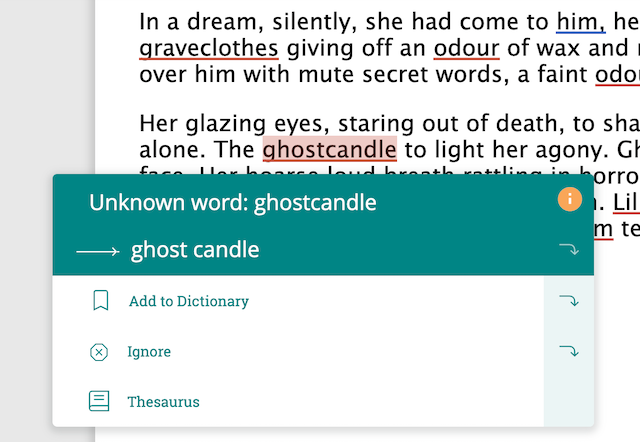
See how Joyce has merged the words graveclothes and ghostcandle to create new terms specific to his character’s perspective?
Stream of consciousness writing will include random thoughts and tangents. Our minds make associations from different thoughts or experiences.
Think about a conversation at the dinner table.
A person is talking about something serious then interjects that the food tastes great, and then it reminds them of another meal they had with a friend from college. Well, I wouldn’t say friend necessarily, but we were friendly. Anyway, back to what I was saying... stream of consciousness can feel random.
Did you pick up on the stream of consciousness in that paragraph?
Stream of consciousness writing also plays with plot structure. The timeline of your story does not have to be linear. Reference memories.
Write about something important that happens then backtrack to how your character got there. You can even make your character an unreliable narrator and have them forget how events occurred!
Use techniques like repetition, asides, and rhetorical questions to capture the flow of your character’s thoughts.
How Does Stream of Consciousness Differ from Other Narrative Styles?
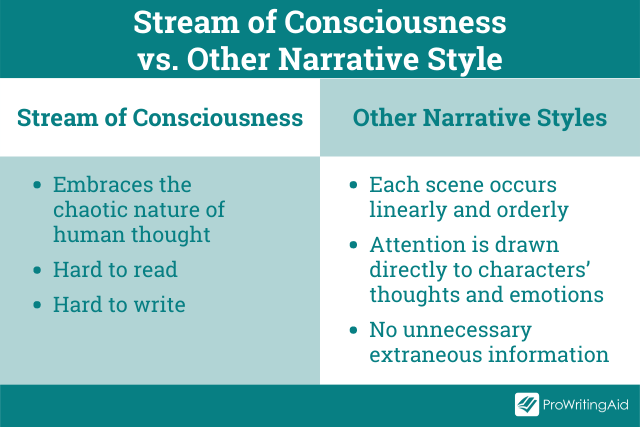
Stream of consciousness embraces the chaotic nature of human thought. But because it’s harder to read and even harder to write, most stories do not use it.
Traditional narrative structure goes relatively in order, although flashbacks and flash forwards can be peppered throughout as their own rhetorical devices. The key to a traditional structure is that each scene occurs linearly and orderly. In a traditional narrative, attention is drawn directly to a character’s thoughts or emotions rather than letting the reader experience those thoughts themselves. These stories don’t have extraneous information that is not crucial to the plot. Emotions are described through sensory detail and character behavior.
Stream of Consciousness vs. Interior Monologue
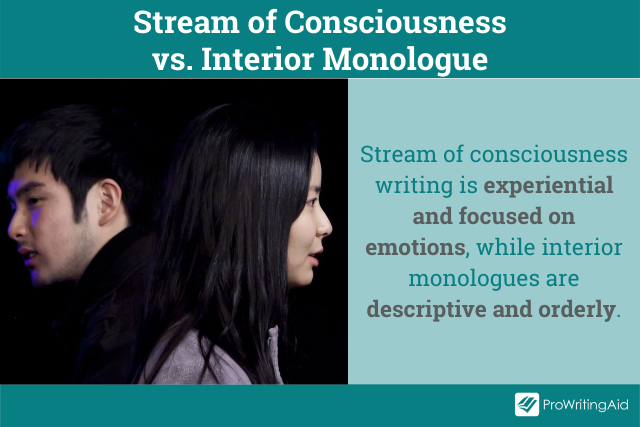
An interior monologue, or internal monologue, does let a reader into the mind of a character. However, this is usually done with accepted grammar and syntax conventions. There are no asides, and it feels orderly even with emotional poignancy.
Stream of consciousness, however, allows readers to feel the emotions with the character. These emotions might not be stated outright. The character might not say they feel sad, but their conscious thoughts turn toward despair.
You can check whether you’re "telling" your characters emotions with ProWritingAid’s emotional tells check.
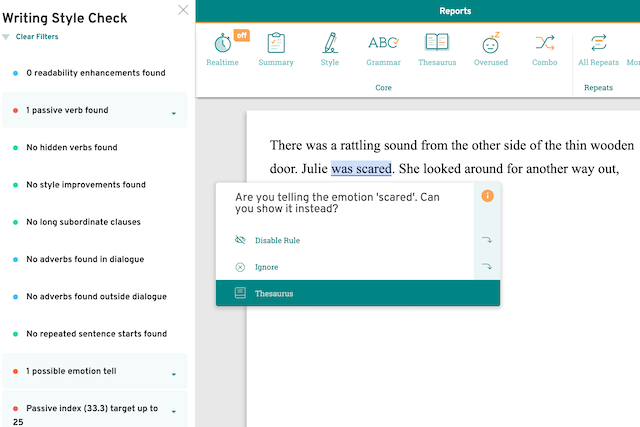
Just upload your manuscript, run the Style Report, and you’ll see all the instances where you’ve told your reader a character was scared (or happy, or angry!) rather than shown it through their thoughts.
In short, stream of consciousness is experiential, while interior monologues are descriptive.
Stream of Consciousness Writing Examples
You’ve probably encountered the stream of consciousness technique before. Here are some examples from literature.
"Clarissa had a theory in those days—they had heaps of theories, always theories, as young people have. It was to explain the feeling they had of dissatisfaction; not knowing people; not being known. For how could they know each other? You met every day; then not for six months, or years. It was unsatisfactory, they agreed, how little one knew people. But she said, sitting on the bus going up Shaftesbury Avenue, she felt herself everywhere; not 'here, here, here'; and she tapped the back of the seat; but everywhere."
—Mrs. Dalloway by Virginia Woolf
"Anyway, I keep picturing all these little kids playing some game in this big field of rye and all. Thousands of little kids, and nobody’s around—nobody big, I mean—except me. And I’m standing on the edge of some crazy cliff. What I have to do, I have to catch everybody if they start to go over the cliff—I mean if they’re running and they don’t look where they’re going I have to come out from somewhere and catch them. That’s all I’d do all day. I’d just be the catcher in the rye and all. I know it’s crazy, but that’s the only thing I’d really like to be. I know it’s crazy."
—The Catcher in the Rye by J.D. Salinger
"I first met Dean not long after my wife and I split up. I had just gotten over a serious illness that I won’t bother to talk about, except that it had something to do with the miserably weary split-up and my feeling that everything was dead. With the coming of Dean Moriarty began the part of my life you could call my life on the road. Before that I’d often dreamed of going West to see the country, always vaguely planning and never taking off. Dean is the perfect guy for the road because he actually was born on the road, when his parents were passing through Salt Lake City in 1926, in a jalopy, on their way to Los Angeles."
—On the Road by Jack Kerouac
"A window, two white curtains. Under the window, a window seat with a little cushion. When the window is partly open—it only opens partly—the air can come in and make the curtains move. I can sit in the chair, or on the window seat, hands folded, and watch this. Sunlight comes in through the window too, and falls on the floor, which is made of wood, in narrow strips, highly polished. I can smell the polish. There’s a rug on the floor, oval, of braided rags. This is the kind of touch they like: folk art, archaic, made by women, in their spare time, from things that have no further use. A return to traditional values. Waste not want not. I am not being wasted. Why do I want?"
—The Handmaid’s Tale by Margaret Atwood
Now you know how to incorporate stream of consciousness effectively in your stories.
What other examples of streams of consciousness can you think of? Have you tried writing with stream of consciousness?


